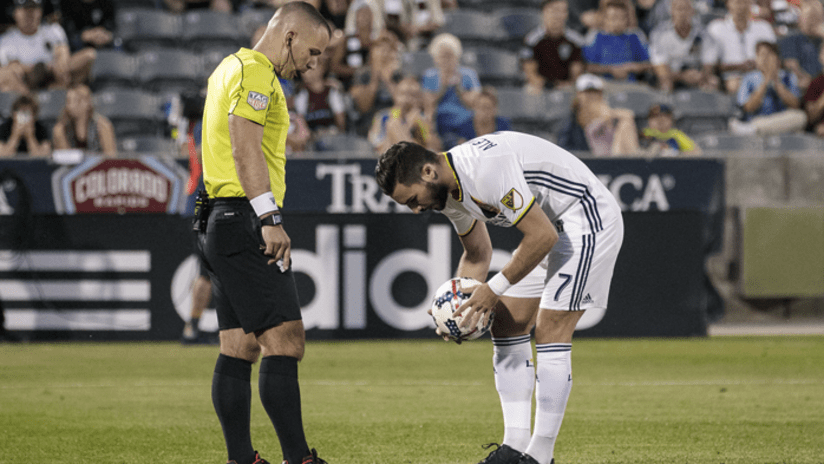Video review is coming to Major League Soccer. Leading up to Saturday’s league-wide launch, whitecapsfc.com is digging deeper into the four match-changing situations eligible for review. Today, we look at goals and penalty decisions and on Friday we will look at red cards and mistaken identity. Also read: The ins and outs of video review in MLS.
GOALS
When it comes to match-changing situations, they don’t get much bigger than goals.
Fans want to see them, players want to score them, and – at the end of the day – it’s goals that will decide the winners and losers in any given game.
“It’s hard to score goals in this sport,” said retired world-renowned FIFA referee Howard Webb, who was brought in to head up the Video Assistant Referee (VAR) program in MLS. “When you do, you don’t want to rule them out wrongly.”
And that is why goals are one of four areas that will be eligible for review under the new VAR program, along with penalty decisions, direct red cards, and cases of mistaken identity.
The Video Assistant Referee will check every single goal that is scored during a match – as well as potential goals that were not awarded – and alert the centre referee to a clear and obvious error in the goal action or the direct build-up to the goal, known as the attacking phase of play.
For example, did the ball cross the line? Was there an offside, handball, or foul in the attacking phase of play? Did the ball go out of play at any point during the attacking phase of play? These are all things the VAR will be looking out for using the camera angles provided by the broadcast.
In the example below, the goal would have likely been called back due to a handball in the attacking phase of play.
“When video review was first thought about by the International Football Association Board, they thought well we can’t just check the incident itself, we have to check what leads up to it,” Webb said. “They thought, well how far do we go back? Two minutes, one minute, 45 seconds? No. We go back to the attacking move that led to that incident. It starts when the team usually moves towards the opponent’s penalty area with some purpose.”
So how does the attacking phase of play relate to set pieces?
The VAR will not be able to review the awarding of corners or free kicks (for example, the foul that led to a free kick or the play that led to a corner) – even if a goal is scored. In those instances, the set piece delivery will essentially begin a new attacking phase of play.
“We can’t go back to review a foul that was committed beforehand,” Webb said.
Similarly, a review cannot take place if the whistle is blown before the ball enters the net when it comes to other infractions such as offsides, fouls, and handballs.
However, if the ball enters the net before the whistle is blown, then the VAR can intervene.
“We are saying to our referees, don’t change the basic way you officiate,” Webb said. “Do it as you’ve always done. Once you’ve made the call, the VAR will check whether it was clear or obviously wrong. The only slight amendment you might see is that if it’s highly likely an imminent goal will be scored in such a situation, then the referees are being told to delay your whistle momentarily to see if that goal does happen. That’s the only real change. Everything else will be the same as it is.”
PENALTY DECISIONS
On May 27 at BC Place, Kendall Waston was called for a penalty on D.C. United forward Jose Ortiz that resulted in the game’s only goal. The ‘Caps lost 1-0 on the night.
And they probably never should have.
Upon replay, it was clear there was no foul on the play and Ortiz was eventually suspended and fined for embellishment.
Now, with video review, there is an opportunity to rectify these sorts of calls.
Penalty decisions are one of four match-changing situations that are eligible for review with the new Video Assistant Referee (VAR) program, along with goals, direct red cards, and cases of mistaken identity. This applies both to penalties that are awarded and ones that perhaps should have been.
“Some of the most significant situations in a match occur in and around the penalty areas,” said Webb. “It’s only right and proper for video review to check whether the awarding or non-awarding of a PK was a clear and obvious error.”
The latter part of that is important to highlight.
The VAR will check all potential penalties using the camera angles provided by the broadcast; however, he or she will only recommend a review to the centre referee in the event of a clear error.
“We ask the question: not was the referee right but was the referee clearly wrong?” Webb said.
In the Waston example above, after reviewing the play upon recommendation of the VAR, the referee would have not only overturned the penalty decision but also shown a yellow card to Ortiz for simulation and awarded Vancouver an indirect free kick.
As is the case with goals, the VAR will also check any potential infractions in the direct build-up to the penalty decision, such as fouls, handballs, and offsides. If there was an infraction, then the PK can be called back. And that would have likely been the case in the play you see below, where Jozy Altidore committed a foul moments before Toronto FC was awarded a PK.
The VAR can also recommend a review if there was an infraction during the taking of a penalty – for example, if a goalkeeper clearly moved off his line to make a save or if one of the on-field players encroached into the penalty area and became directly involved in the play.


